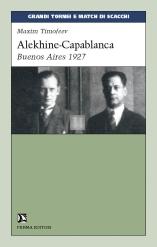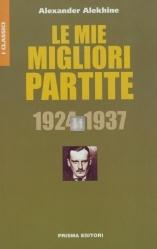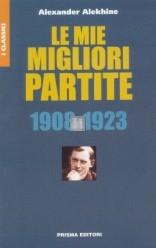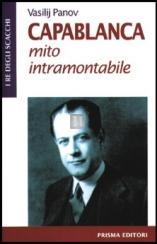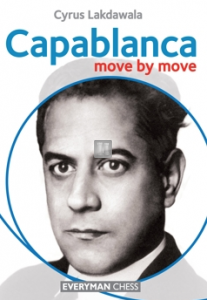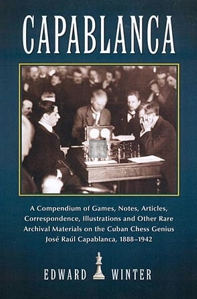The stories, games and intrigues of CAPABLANCA & ALEKHINE
Siles Luis Fernández

What is this book about?
It details the rivalry between José Raúl Capablanca and Alexander Alekhine. It also introduces the people and events around these giants of chess history and is a historical book of great relevance. It runs as follows:
· Foreword by Manuel Azuaga
· Introduction
· 16 Chapters
· Epilogue
· Index of games
· Index of names
· Bibliography
Descrizione
What is this book about?
It details the rivalry between José Raúl Capablanca and Alexander Alekhine. It also introduces the people and events around these giants of chess history and is a historical book of great relevance. It runs as follows:
· Foreword by Manuel Azuaga
· Introduction
· 16 Chapters
· Epilogue
· Index of games
· Index of names
· Bibliography
My thoughts and comments
I am going to begin at the end. I thoroughly enjoyed this book and I have no hesitation in recommending it to everyone! I read it in three sittings to the exclusion of everything else. Firstly, how does this self-published tome look and feel? The (hardback) cover design is superb with the protagonists sitting at the chessboard oblivious of the background depicting the carnage and horror of war. They lived after all through WWII. Capablanca is studying the board whilst Alekhine looks away, seemingly lost in thought as well as (perhaps) the game. It is a brilliant idea, and credit to the designer Esther Alcedo Fuentes. The pages are of superior quality, with the font and diagrams being second to none.
I liked the look and feel of the book, and appreciate chess still being published in this format. It is liberally sprinkled with photographs that add value and meaning to the chapters. These include not only well-known images such as the sad depiction of Alekhine dead at the board in his hotel room in Estoril, Portugal (there’s a conspiracy piece about that in the chapter) but group photographs of other players in important competitions such as Pasadena 1932 and Wiesbaden 1929. I also love the group shot at Nottingham 1936. The reader will see and learn who Arthur John Mackenzie was, too.
We are told that initially Capablanca and Alekhine got on very well, but after the latter had wrested the World Title from Capablanca in 1927 he refused to give him a rematch, making any number of excuses. I was reminded of Staunton and Morphy in the same vein. The author skillfully builds the story of their relationship over the years, culminating in the fact that at one point they refused even to be seen in the same room. I felt drawn into this, as if I were back in time witnessing these events. Reading about these two giants of chess, with all the background details was a delight for me, and I did learn some new things about both players.
In one way I wanted to ‘take sides’ yet the fact is I am able to enjoy both players and their chess, regardless of their antics off the board. Capablanca did not like study and he was the more natural player whereas Alekhine was obsessed with study, analysis and improvement. Capa was supposed to be the endgame expert (and he was) showing depth and understanding in that aspect of the game whereas Alekhine was the one with flashes of brilliance and dashing attacks. Yet both were capable of either. José liked his women, and partying, Alexander had a penchant for alcohol. Both were chess gods in the world of 64 squares and both left legacies for us all, forever.
There is so much more in this book including Alekhine’s joke, blindfold chess in prison, early examples of The London System instructive draws, Capa’s worst ever game, Lasker’s double bishop sac, Lilienthal’s famed queen sacrifice against Capablanca, Botvinnik’s legendary 30.Ba3!! against Capa, what Crapuloso means and much more. It’s a treasure trove of information with games and anecdotes to support the whole period. The Second World War greatly affected Alekhine in particular and chess in general. Was he an antisemite? After reading what the author provides, we must draw our own conclusions. For the Cuban his motivation seemed to (understandably) revolve around securing that rematch for the World Championship. It must have driven him crazy not being able so to do.
Game choice
There are 85 games. They are as instructive and interesting as one would expect from not only the two lead characters but also their opponents, including Lasker, Bogoljubow, Euwe, Nimzowitsch and Marshall to name a few. What really makes this book for me – and it is the most important point I can make – are the tremendous annotations from the author. Rarely have I read such an appealing style which players of all levels can understand. In a world where annotations can be very lazy, merely repeating what the engine says, Siles will go on to explain why he thinks the evaluations are so. He has a very clear way of explaining things and for me it was a true joy to follow, from beginning to end. He is one of the best I have read and that is a big compliment!
Informazioni
- Codice 8735
- Anno 2025
- Pagine 440
- Isbn 9798263832537
 Italiano
Italiano
 English
English


